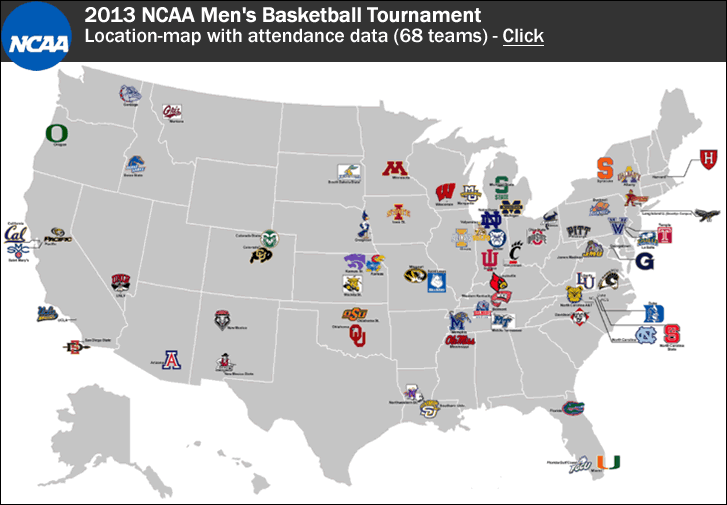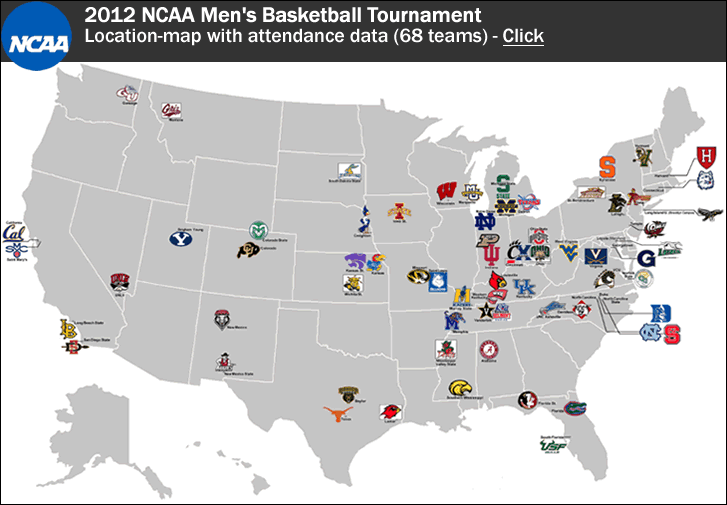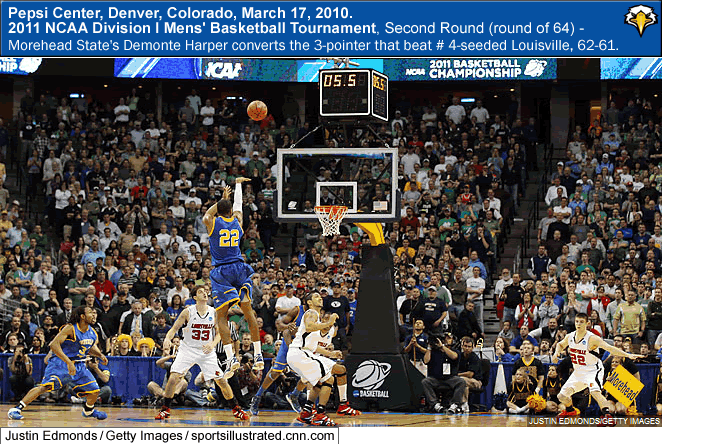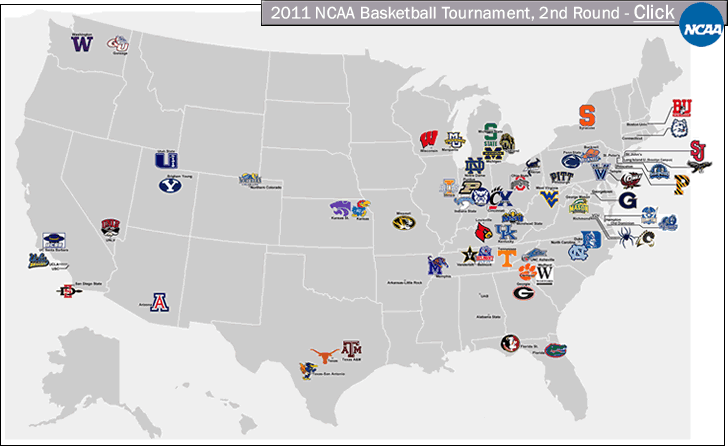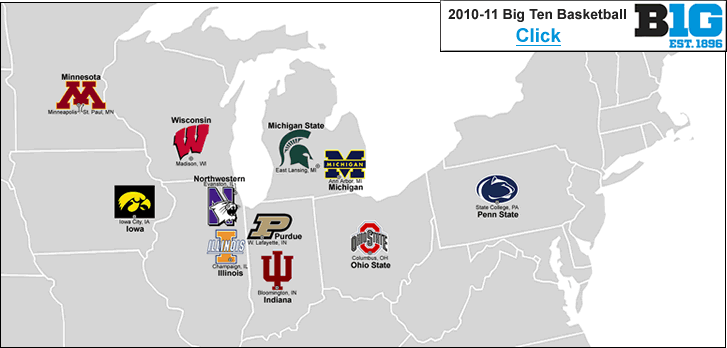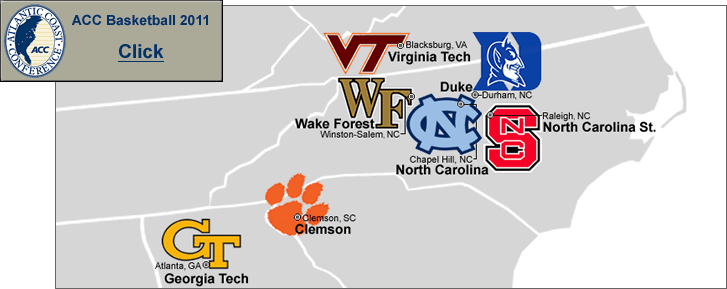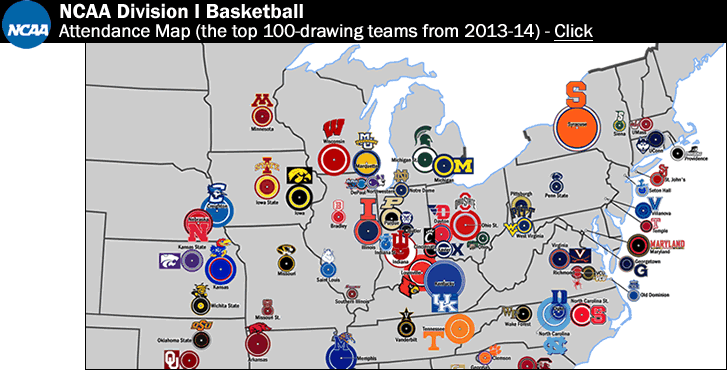
NCAA Division I Men’s Basketball – map of the top 100 drawing teams, 2013-14 season
…
…
Source of data for map…2014 NCAA MEN’S BASKETBALL ATTENDANCE [pdf].
My first version of this map can be seen here, NCAA Division I Men’s Basketball – The top 100 drawing teams, 2009-10 season (home games, regular season).
That was four years ago. Since then, 10 different teams have cracked the top 100: #68th-highest-drawing Weber State Wildcats, #69th-highest-drawing Boise State Broncos, #72th-highest-drawing Northwestern Wildcats, #77th-highest-drawing UMass Minutemen, #86th-highest-drawing Richmond Spiders, #90th-highest-drawing Indiana State Sycamores, #93rd-highest-drawing Miami Hurricanes, #95th-highest-drawing SMU Mustangs, #97-highest-drawing Southern Illinois Salukis, and #100th-highest-drawing Wyoming Cowboys. Teams that just missed the top 100 for 2013-14: Stanford (5,111), Toledo (5,002), TCU (4,955), George Mason (4,916), Illinois State (4,842).
And of a more front-page-type bit of news, there is a new #1-drawing college basketball team in Division I…
The Syracuse Orange of Syracuse, New York (metro-area population: 662,000 {2010 figure). The Orange’s basketball team has supplanted the University of Kentucky Wildcats (of Lexington, Kentucky) as the top draw in college hoops. Syracuse last led the nation in college basketball attendance in 2005. But in 17 of the 18 previous seasons (1996-2004; 2006-13), Kentucky has led in attendance. Kentucky had also led in attendance during the 1977 to 1984 time period (8 seasons), with Syracuse (after the Carrier Dome had opened in Sept. 1980) then leading in the 1985 to 1995 time period (10 seasons). {See this, NCAA Division I Men’s Basketball Attendance Leaders Year by -Year (1970-2014) [pdf].}
Syracuse averaged 26,253 in the 2013-14 NCAA Division I regular season. They increased their home crowds by 3,813 per game (or by 16.9%) compared to the previous season (2012-13). That actually was not the largest numerical increase in crowd size in Division I basketball – that was by the Nebraska Cornhuskers, who increased their average attendance by 5,063 per game (or 48.8%), and were the 13th highest-drawing college bk team {see this list of biggest increases on page 2 of that pdf from the ncaa.org}. Nebraska were also one of the eight teams in the top-100-draws who played to full-capacity last season, and on the list at the far right of the map page, those 8 teams have an asterisk next to their attendance figure (the list of the 8 teams who played to full-capacity at their arenas last season can be found at the foot of this post).
Syracuse’s attendance increase (of 16.9% or +3,813) certainly was aided by a strong Syracuse team and a long winning streak, but it is more attributable to Syracuse’s shift from the now-mid-major Big East Conference into the basketball power that is the Atlantic Coast Conference (the ACC). To see the proof of that, just look at the gate figures for some of Syracuse’s in-conference games last season at the Carrier Dome (capacity 35,446 for basketball), 2013-14 being the Syracuse Orange’s inaugural season in the ACC…
- 32,121 in attendance for the Oranges’ Jan. 11 2014 game vs. the North Carolina Tar Heels (in ACC) (57-45, Syr.);
- 30,046 in attendance for the Oranges’ Jan. 18 2014 game vs. the Pitt Panthers (also now in ACC) (59-54, Syr.);
- 35,466 (capacity sell-out crowd/NCAA record) in attendance for the Orange’s Feb. 1 2014 game vs. the Duke Blue Devils (in ACC) (91-89/OT, Syr.);
- 31,572 in attendance for the Orange’s Feb. 15 2014 game vs. the NC State Wolf Pack (in ACC) (56-55, Syr.).
- Note: other high-drawing games at the Carrier Dome last season: 28,135 for Villanova (in Big East); 26,766 for Georgia Tech (in ACC); 26,716 for Boston College (in ACC since 2005); 26,414 for Indiana (in Big Ten). {attendances from Syracuse Orange men’s basketball team/Schedule (en.wikipedia.org).
Syracuse flamed out in the second round of the NCAA Tournament (losing to Dayton), but they had a good run and filled a heck of a lot of seats last season, and it is starting to look like being in the ACC will give a real boost to the whole Syracuse athletics program.
The Kentucky Wildcats were #2 in attendance in Division I basketball for 2013-14. The Wildcats saw a slight decrease from the previous season of -135 per game (or -0.6%). Kentucky drew 23,964 per game in 2013-14, and had drawn 23,099 per game in 2012-13. The Kentucky Wildcats’ great drawing-power is rather remarkable for a city – Lexington, KY – that has a metro-area population of only 185,000 {2013 figure}.
The Louisville Cardinals were #3 in attendance in Division I (at 21,282 per game), once again making it two of the top 3-highest-drawing venues in college basketball located in the Commonwealth of Kentucky. From the Louisville Courier-Journal, from 19 June 2014, by Jonathan Lintner, Syracuse tops UK in basketball attendance; [Kentucky second;] U of L third (courier-journal.com/story/sports/college).
Here are the 8 teams in the top-100 who played to full capacity in 2013-14:
#9-drawing Kansas Jayhawks, who played to 100.8 percent-capacity, drawing 16,437 per game at the 16,300-capacity Allen Fieldhouse in Lawrence, Kansas.
#13-drawing Nebraska Cornhuskers, who played to 101.7 percent-capacity, drawing 15,419 per game at the 15,147 Pinnacle Bank Arena in Lincoln, Nebraska.
#18-drawing Michigan State Spartans, who played to 100.0 percent-capacity, drawing 14,797 per game at the Breslin Center in East Lansing, Michigan.
#28-drawing San Diego State Aztecs, who played to 100.0 percent-capacity, drawing 12,414 per game at the Viejas Arena in San Diego, California.
#36-drawing Wichita State Shockers, who played to 102.1 percent-capacity, drawing 10,732 per game at the 10,506-capacity Charles Koch Arena in Wichita, Kansas.
#46-drawing Duke Blue Devils, who played to 100.0 percent-capacity, drawing 9,314 per game at the Cameron Indoor Arena in Durham, North Carolina.
#62-drawing VCU Rams, who played to 100.6 percent-capacity, drawing 7,741 per game at the 7,693-capacity Stuart C. Siegel Center in Richmond, Virginia.
#87-drawing Gonzaga Bulldogs, who played to 100.0 percent-capacity, drawing 6,000 per game at the McCarthey Athletic Center in Spokane, Washington.
___
Thanks to AMK1211 for blank map of USA, ‘File:Blank US Map with borders.svg”>File:Blank US Map with borders.svg‘ (commons.wikimedia.org).
Thanks to ncaa.org for 2014 NCAA MEN’S BASKETBALL ATTENDANCE [pdf].
Thanks to Sports Logos screensavers for some of the logos, sports-logos-screensavers.com/NationalCollegiateAthleticsAssociation. Thanks to ESPN site for some of the logos (the often-hard-to-find type, with a transparent background), such as at espn.go.com/mens-college-basketball/team/_/id/113/massachusetts-minutemen.
Thanks to the contributors at the en.wikipedia.org college teams pages, such as Syracuse Orange men’s basketball.

